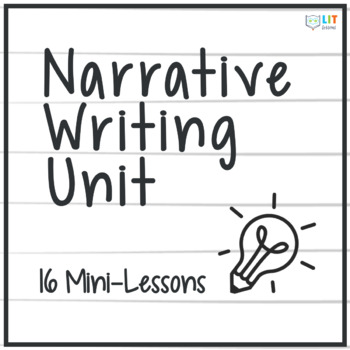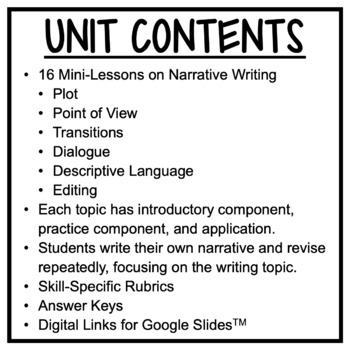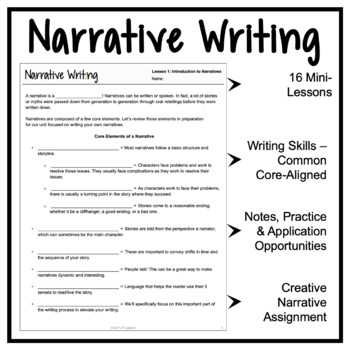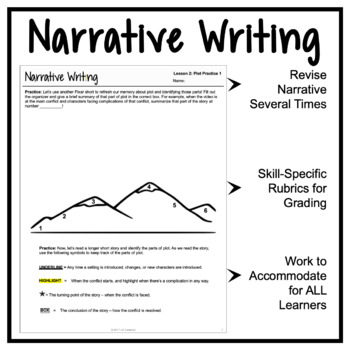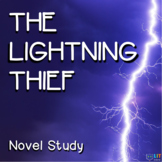Narrative Writing Unit: 16 Mini-Lessons to Master Narratives in Grades 6-8
- Zip
What educators are saying
Also included in
- The Percy Jackson and the Lightning Thief Novel Study is a comprehensive set of instructional materials for teaching Percy Jackson and The Lightning Thief by Rick Riordan. With over 100+ Common Core aligned materials, students will develop their literacy skills while deeply engaging with The LightniPrice $30.00Original Price $42.00Save $12.00
- This product is a comprehensive set of instructional materials for teaching Hello, Universe by Erin Entrada Kelly. With over 100+ Common Core aligned materials, students will develop their literacy skills while deeply engaging with the novel. Plus, the fiction close reading activities, the literaryPrice $30.00Original Price $45.00Save $15.00
Description
The writing resources include 16 mini-lessons that guide students to master skills essential to narrative writing. The lesson topics cover plot, point of view, transitions, dialogue, and descriptive language. For each topic, the resource comprises of three lessons – the first introduces the skill, the second has students practice the skill, and the third has students apply the skill in their own writing. In addition, the resource also includes the basics of editing narratives with a checklist for students to use for peer or self-editing. The resources also contain a summative narrative writing assignment, aligned rubrics, and answer keys.
Digital Links: The resource includes links for students to complete the student pages in Google Slides™. Text boxes are already created for students. They will also need to be able to highlight text and underline text in some instances. If you have questions about the digital compatibility or would like to see a sample prior to purchase, please reach out to the email listed below.
Plot Mini-Lessons:
1. The first lesson introduces the students to the basics of plot. Students fill out guided notes with definitions. Then, there is space for students to fill out plot graphs for short videos. The videos are not included and must be procured by the teacher. I suggest using Pixar short films for analyzing plot. They typically include all the narrative elements and are entertaining for the kids to watch.
2. The second lesson has space for students to practice identifying elements of plot with another short film. Then, students read a fairytale by Hans Christian Anderson and analyze the story for plot elements.
3. Finally, students are provided a brief short story prompt to stimulate ideas for their own narrative. As they generate their idea, there is an outline and plan to help them organize their writing.
Point of View Mini-Lessons:
1. The first lesson teaches the different types of points of view using a picture. The students take notes on the different types of point of view and end the lesson by identifying point of view in mini-paragraphs.
2. The second lesson has students practice identifying point of view in mini-paragraphs with the same 4-step process taught the prior lesson.
3. The last lesson has students examine the point of view of the narrative they started composing in the last plot lesson. Students rewrite sections in different points of view before deciding the best one for their story. Finally, they will rewrite their story, correcting any plot mistakes and revising the point of view.
Transitions Mini-Lessons:
1. The first lesson has students fill out a chart of various transitions and their purpose.
2. In the next lesson, students use their chart to fill in transitions for paragraphs that have them omitted. Students can work in groups or pairs to stimulate discussion as to which transitions are appropriate.
3. In the final lesson, students identify the transitions in their narrative and explain why they chose them. Students then rewrite their narrative to incorporate appropriate transitions and create a story that seamlessly advances ideas using transitions to connect time and place.
Dialogue Mini-Lessons:
1. The first mini-lesson covers the rules of incorporating basic dialogue in a narrative. The rules go over punctuation, formatting, speaker, and variety.
2. The second lesson uses short excerpts from Percy Jackson without proper dialogue. Students rewrite the paragraphs using the dialogue rules. Student groups can be a great way to have students talk about proper dialogue use.
3. The last lesson asks students to pick several areas of their own narrative to rewrite with dialogue. Students copy the sections then rewrite them with more colorful dialogue. As always, students engage in rewriting their narrative in order to revise, refine, and incorporate the basic story elements.
Descriptive Language Mini-Lessons:
1. The first descriptive lesson covers imagery and the four types of figurative language. The class can work to complete a chart that sees them actively transform non-descriptive sentences into descriptive ones.
2. The next lesson is another chart of non-descriptive language that students rewrite to make descriptive. The second lesson is another great place to have students work together. The skill can be difficult for some so cooperative groups may be effective.
3. The last lesson requires students to identify non-descriptive language in their own narratives. Then, they rewrite the sentences to include more descriptive language. At this time, students also complete the final rough draft of the narrative to prepare for editing.
Editing Mini-Lesson: The mini-lesson uses a checklist to edit narratives for the basic elements of narrative writing covered through the prior mini-lessons. The lesson also covers three general rules for providing feedback. A checklist is provided for students to use when reading each other’s narrative. After peer editing, students can publish their final narrative.
The mini-lessons encompass all the common core standards for narratives. Although the standards below are based on seventh grade, the mini-lessons can apply to any elementary or middle school context.
While students build their skills during the mini-lessons, they also actively produce a narrative to demonstrate their understanding. In addition, the writing resources also include a final narrative project to allow students to practice the application of their knowledge again. The project asks students to develop their own narrative, incorporating all the skills they’ve learned from the mini-lessons. All resources have an accompanying answer key, and all writing assignments come with rubrics.
PLEASE NOTE: This resource is NOT EDITABLE! It is intended to be comprehensive, but if you have particular needs for your classroom, please contact me! (lauren@lit-lessons.com)

